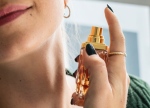This post continues with assessing the factual accuracy of the perfume references in the script of the German TV show Parfum, made for Netflix. Each episode in the series begins with a statement about perfume and how we perceive it. The statements, within the parameters of the plot about desire and murder, are generally in line with how perfume and the sense of smell actually work. In the previous posts, I discussed the script references to Ambra (ambergris), Skatol (skatole), Synthese (the synthesis or composition of a perfume) and The Third Substance, which is about the distillation of perfume. In this final post, I discuss The Heart Notes and Captivation.

“The Heart Notes”
“They say perfume unfolds linear in time, and consists of the sequence top note, heart note and base note.
Quite an error. […]
Good perfume is far more complex.
It’s a process creating tension through the reaction of the substances, setting high and low points, playing with variations of intensity.
When the togetherness of the substances creates its own sound, that’s the real heart note of the perfume.” (Script extract, Parfum TV series)
Commentary
This is correct, however the core or most lasting note in a perfume is not the heart note, but the base note. A perfume has top or head notes, middle or heart notes and base notes. This means that every time you apply a perfume, you go through a time-line of memories evoked by the substances of which the perfume is made. Each “set” or collection of notes is designed to leave you with an impression, and the base note leaves the longest and therefore the most memorable impression.
- Top notes are those smells that can be smelled and identified immediately after perfume is applied. Ingredients that give off these notes consist of small molecules that evaporate quickly. This is what you smell when you spray it one in a shop.
- Middle notes can be discerned when top notes start dissipating. These notes are usually more mellow and can appear in the smell somewhere between two minutes and one hour after the perfume is applied. Middle or heart notes are often used to “blend” or “soften” the first, strong whiffs of the base notes that follow.
- Base notes are smelled third, and bring depth and solidity to a perfume and their odour lasts the longest. They appear when middle tones start disappearing and can last up to 24 hours. Molecules of ingredients that are used for base notes evaporate very slowly and their scent is usually rich, strong and evocative.
When people complain that the smell that they got in the shop when they bought the perfume doesn’t last, it is because they smelled the top note, and perhaps the middle note while they were in the shop. But the note that should last for at least a day is the base note, which will only emerge later, and will smell different depending on what the wearer would be doing – like sweating or eating.
Any perfume will smell different depending on a person’s individual skin type.
“Perfume experts cannot stress this enough: what smells good on one person may smell different on another. It’s not just a matter of taste or preference or a matter of how the nose perceives a certain smell. Rather, it’s a matter of how the body reacts with the ingredients of a certain fragrance. The truth is that a brand of perfume can be the Number 1 best-selling fragrance across the globe but it’s not going to smell great on everyone because of each person’s unique body chemistry [such as how much oil or sweat is in the skin].” (How Body Chemistry Affects Perfume, June 6, 2016, beureka.com)
That’s why you are advised to apply your perfume to places where your skin is sweaty and moist, for maximum absorption like your neck, behind your ears, the backs of your knees, your belly button, your cleavage or your hair. Spraying it on your wrists or your clothes, or in the air around you, won’t work as well.

“Captivation”
“Scents are elusive.
Barely touching our skin, they go on their journey away from us again.
The perfumer dabbles in the art of captivating what in its heart desires to escape, without destroying its soul.” (Script extract, Parfum TV series)
Commentary
True enough. Perfume wearing is something very personal. If you give someone perfume as a gift, you had better know them intimately. I once got given an expensive bottle of Red Door by Elizabeth Arden as a present. All I got from it was a most terrible migraine. What smells heavenly on me and to me, may smell unpleasant on or to the next person. You never can tell. As famous perfumer Jean-Claude Ellena wrote in The Diary of a Nose:
“Two years ago, in July, I drove some visitors through the Hautes Alpes region to see the fields of lavender and smell the clary sage. When we had reached the austere and beautiful site, some of the guests climbed swiftly back into the bus to get away from the human sweat smell of the sage that the wind was wafting into our nostrils. I myself was quite happy for these flowers to give me the smell of my own bestiality, my non-eternity, the smell of life.” (Jean-Claude Ellena, The Diary of a Nose – A Year in the Life of a Perfumeur, p. 100)

Another teaser to the Parfum TV show
Image credits for post copy: Image 1253588 from rawpixel.com on pexels.com, Pexels License CC0 ✓ Free for personal and commercial use ✓ No attribution required, rtrvd. 2019-03-14
Image credit for header: Image 6404 from kaboompics.com on pexels.com, Pexels License CC0 ✓ Free for personal and commercial use ✓ No attribution required, rtrvd. 2019-03-14




You must be logged in to post a comment.